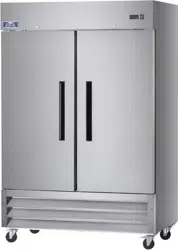Loading ...
Loading ...
Loading ...

10
Installation, Operation & Maintenance Manual
REACH-IN REFRIGERATORS AND FREEZERS
MAINTENANCE
DANGER
TURN OFF THE POWER SWITCH AND
DISCONNECT THE UNIT FROM THE POWER
SOURCE WHENEVER PERFORMING SERVICE/
MAINTENANCE FUNCTIONS AND/OR
CLEANING THE REFRIGERATED AREA.
Refrigerators and Freezers
Clean the interior and exterior using soap and warm wa-
ter. If this is not sufcient, use ammonia and water or a
nonabrasive liquid cleaner. When cleaning the exterior,
always rub with the stainless steel grain to avoid marring
the nish.
Do not use an abrasive cleaner, it may scratch the stain-
less steel and/or the plastic. Abrasive cleaners can also
damage the breaker strips and gaskets.
Cleaning the Condenser Coil
Clean the condenser coil a minimum of every 90 days.
If there is a large amount of debris, dust or grease ac-
cumulation prior to the 90 day cycle, reduce the cleaning
cycle to every 30 days.
If the buildup on the coil consists of only light dust and
debris, clean the condenser coil using a brush. For
heavier dust buildup, use a vacuum or compressed air.
If heavy grease is present use a refrigeration degreas-
ing agent designed specically for the condenser coils.
Spray the condenser coil with degreasing agent and
blow through with compressed air.
Failure to maintain a clean condenser coil can initially
cause high temperatures and excessive run times. Con-
tinuous operation with dirty or clogged condenser coils
may result in compressor failures. Neglecting the con-
denser coil cleaning procedures will void any warranties
associated with the compressor.
CAUTION
Never use a high pressure water wash for this
cleaning procedure as water can damage the
electrical components located near or on the
condenser coil.
Stainless Steel Care and Cleaning
Stainless steel contains 70-80% iron which will rust. It
also contains 12-30% chromium which forms an invis-
ible passive lm over the steel’s surface that acts as a
corrosion shield. As long as the protective layer remains
intact, the metal remains stainless. If the lm is broken
or contaminated, outside elements can break down the
steel and begin to form rust or discoloration.
To properly clean stainless steel, use soft cloths or plas-
tic scouring pads.
CAUTION
Never use steel pads, wire brushes or scrapers to
clean stainless steel surfaces.
Cleaning solutions must be alkaline based or non-chlo-
ride cleaners. Any cleaner containing chlorides will dam-
age the stainless steel protective lm. Chlorides are also
commonly found in hard water, salts, and household and
industrial cleaners. If cleaners containing chlorides are
used, be sure to rinse repeatedly and dry thoroughly
upon completion.
Perform routine stainless steel cleaning with soap and
water. Extreme stains or grease should be cleaned with
a non-abrasive cleaner and plastic scrub pad (rub with
the grain). There are also stainless steel cleaners avail-
able which can restore the protective layer and preserve
the nish.
Early signs of stainless steel breakdown may consist of
small pits and cracks. If these early signs are present,
clean thoroughly and apply a cleaner specically de-
signed for stainless steel cleaners to attempt to restore
the passivity.
CAUTION
Never use an acid based cleaning solution. In
addition, many food products have an acidic
contentwhichcandeterioratethenish.Besure
to clean the stainless steel surfaces of all food
products. Common acidic based food items
include; tomatoes, peppers and other vegetables.
Loading ...
Loading ...
Loading ...
